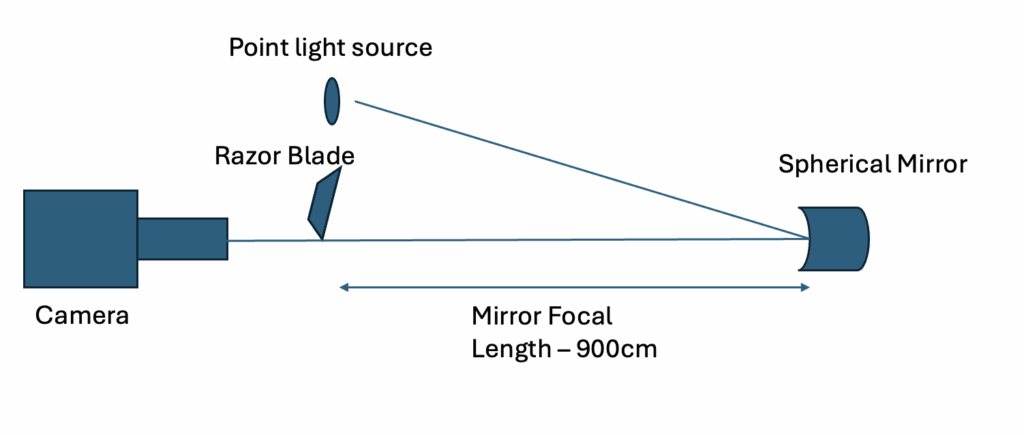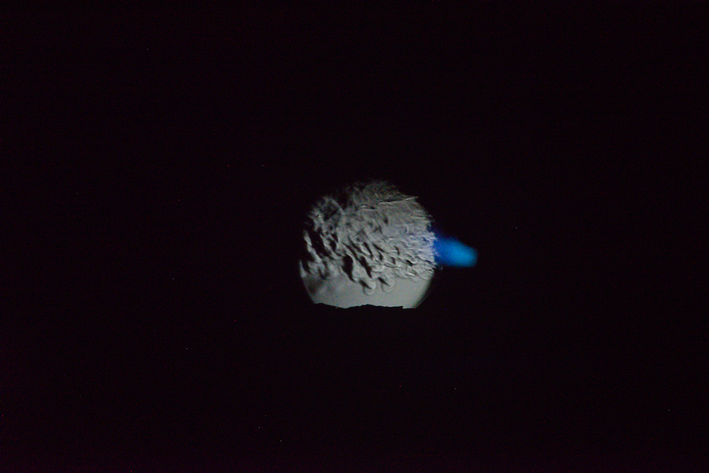Our team (team 11), used a spherical mirror, pin point light, and a razor blade to show the changes in air density by using the schlieren effect. Pictured here is a plumbing torch blowing hot air across the mirror showing the convective currents.
The purpose of this work was to use schlieren imaging to reveal convective currents produced by a handheld blowtorch. Artistically, the goal was to create a visualization of turbulence and convection. Scientifically, the intent was to capture refractive index gradients caused by temperature variations, illustrating the physics of buoyancy, turbulence, and thermal mixing. This work was performed with Team 11, Jake Jones and Will Bell.
The flow, shown in appendix A figure 1, was generated by a blowtorch, fueled with MAPP gas, directed across the field of view of a spherical mirror. The 4.5” diameter, 900 cm focal length, spherical mirror created strong separation in the refraction of the different density of air produced. The hot exhaust plume, with typical flame temperatures around 2200 K, produced large refractive index differences relative to the surrounding 300 K ambient air. The air flow has an estimated velocity of 2–5 m/s and the Eddy currents shown are around 1–2 cm.
Schlieren imaging shows the changes in air temperature altering its refractive index, causing light to bend slightly (Settles, 2001). In this setup, a 400 lumen headlamp shining through cardboard with a pinhole created a near-point light source. Light reflecting from the spherical mirror was focused at its focal point, where a razor blade was positioned as a knife edge. The knife edge is positioned to block half of the light from entering the camera. Regions of higher density gradient appeared darker, because of the light source being blocked, while less-deflected regions appeared lighter because of the light source shining through . The camera, aligned with the mirror, recorded these variations as the textures seen in the final image. This setup, though simple, is sensitive to refractive gradients and allows direct visualization of convection and turbulence.
Characterizing flow:
Reynolds number: = (1.2 × 3 × 0.02) / (1.8 × 10⁻⁵) = 4000, indicating turbulent flow.
Grashof number: With ΔT = 1900 K, Gr > 10⁶, confirming buoyancy-driven instability (Turner, 1973).
Visualization Technique:
The schlieren setup used:
– Mirror: 4.5” diameter, 900 cm focal length spherical mirror
– Light source: 400 lumen headlamp with cardboard pinhole
– Knife edge: razor blade at focal length
– Torch: handheld MAPP gas plumbing torch
A sketch of the setup is shown in appendix A. This arrangement creates dramatic flows, shown by the characteristic numbers, and highlights refractive index changes.
Photographic Technique:
Camera: Nikon Z5, 200 mm lens.
Resolution: Uncropped 6000 × 4000 px, cropped ~4000 × 2500 px.
Exposure: f/6.3, shutter 1/1600 s, ISO 10000.
Depth of field: focused on plate at which torch flame is at
Time resolution: At 3 m/s torch speed, blur during 1/1600 s exposure is effectively frozen motion.
Post-processing: minor cropping and contrast adjustments; no alteration of flow features.
The final image reveals convection as jagged peaks of air above the blowtorch jet. The artistic impact comes from the abstraction of invisible physics into visible texture, enhanced by the dark background and careful cropping. The blue torch flame serves as a vivid accent color against grayscale schlieren gradients. Scientifically, the image demonstrates buoyancy-driven turbulence and shear instability in heated air. One limitation is the slight background noise from imperfect alignment of the knife edge. Improvements could include a brighter point light source, finer knife edge adjustment, or high-speed imaging to resolve unsteady structures.
References
Settles, G. S. (2001). Schlieren and Shadowgraph Techniques: Visualizing Phenomena in Transparent Media. Springer.
Turner, J. S. (1973). Buoyancy Effects in Fluids. Cambridge University Press.
Appendix A:

Figure 1: Cropped Image

Figure 2: Uncropped Image

Figure 3: Sketch of setup


2 Comments. Leave new
I love the depth present in this image, seems like you got the exposure perfect with your knife edge placement.
Did you consider burning different gases to see how they would look different? Great job, its cool to see how the flow progresses as it get further from the torch.